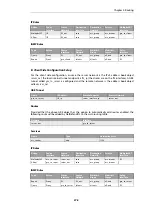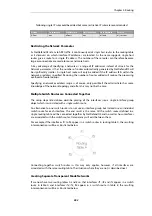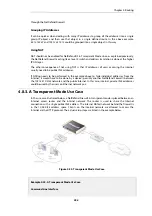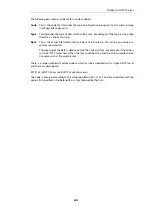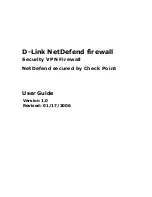
without needing to perform route lookups and therefore increase processing speed. In addition
to overall faster traffic movement, MPLS also makes it easier to manage
Quality of Service
(QoS).
MPLS is considered to be "multi-protocol" because it works with the Internet Protocol,
Asynchronous Transport Mode
(ATM) and frame relay network. When considered in reference to
the OSI network model, MPLS allows packets to be forwarded at the layer two level rather than at
the layer three level and for this reason it is said to operate at the two and a half level.
NetDefendOS MPLS Support
NetDefendOS supports
MPLS Pass Through
. This is relevant in transparent mode scenarios where
the MPLS labeled packets are allowed to traverse the NetDefend Firewall. NetDefendOS can
optionally validate the integrity of these MPLS packets and the administrator can change the
advanced setting Relay MPLS to specify the specific action to be taken. The possible values for
this setting are:
•
Ignore - Verify packets and allow all verified MPLS labeled packets to pass silently. Packets
that fail verification are logged.
•
Log - Verify packets and allow all verified MPLS packets to pass as well as being logged.
Packets that fail verification are also logged.
•
Drop - Silently drop all MPLS packets without verification or logging.
•
Drop/Log - Drop all MPLS packets without verification and log these drops.
4.8.6. Advanced Settings for Transparent Mode
CAM To L3 Cache Dest Learning
Enable this if the firewall should be able to learn the destination for hosts by combining
destination address information and information found in the CAM table.
Default:
Enabled
Decrement TTL
Enable this if the TTL should be decremented each time a packet traverses the firewall in
transparent mode.
Default:
Disabled
Dynamic CAM Size
This setting can be used to manually configure the size of the CAM table. Normally
Dynamic
is
the preferred value to use.
Default:
Dynamic
CAM Size
If the Dynamic CAM Size setting is not enabled then this is the maximum number of entries in
each CAM table.
Chapter 4: Routing
390
Содержание NetDefendOS
Страница 30: ...Figure 1 3 Packet Flow Schematic Part III Chapter 1 NetDefendOS Overview 30 ...
Страница 32: ...Chapter 1 NetDefendOS Overview 32 ...
Страница 144: ...Chapter 2 Management and Maintenance 144 ...
Страница 220: ... Enable DHCP passthrough Enable L2 passthrough for non IP protocols 4 Click OK Chapter 3 Fundamentals 220 ...
Страница 267: ... SourceNetwork lannet DestinationInterface any DestinationNetwork all nets 4 Click OK Chapter 3 Fundamentals 267 ...
Страница 284: ...Chapter 3 Fundamentals 284 ...
Страница 360: ...The ospf command options are fully described in the separate NetDefendOS CLI Reference Guide Chapter 4 Routing 360 ...
Страница 392: ...Chapter 4 Routing 392 ...
Страница 396: ...Web Interface 1 Go to Network Ethernet If1 2 Select Enable DHCP 3 Click OK Chapter 5 DHCP Services 396 ...
Страница 419: ... Host 2001 DB8 1 MAC 00 90 12 13 14 15 5 Click OK Chapter 5 DHCP Services 419 ...
Страница 420: ...Chapter 5 DHCP Services 420 ...
Страница 424: ...2 Now enter Name lan_Access Action Expect Interface lan Network lannet 3 Click OK Chapter 6 Security Mechanisms 424 ...
Страница 573: ...Chapter 6 Security Mechanisms 573 ...
Страница 575: ...This section describes and provides examples of configuring NAT and SAT rules Chapter 7 Address Translation 575 ...
Страница 607: ...Chapter 7 Address Translation 607 ...
Страница 666: ...Chapter 8 User Authentication 666 ...
Страница 775: ...Chapter 9 VPN 775 ...
Страница 819: ...Chapter 10 Traffic Management 819 ...
Страница 842: ...Chapter 11 High Availability 842 ...
Страница 866: ...Default Enabled Chapter 13 Advanced Settings 866 ...
Страница 879: ...Chapter 13 Advanced Settings 879 ...



